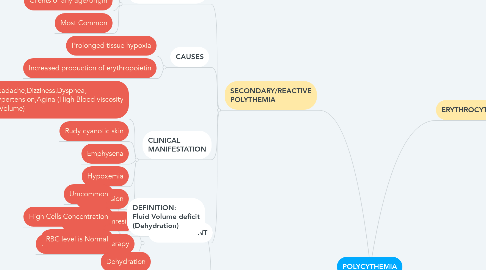
1. SECONDARY/REACTIVE POLYTHEMIA
1.1. DEFINITION: Excessive production of RBC
1.1.1. High level of erythropoietin
1.1.2. Response to reduced amount of O2
1.1.3. Clients of any age/origin
1.1.4. Most Common
1.2. CAUSES
1.2.1. Prolonged tissue hypoxia
1.2.2. Increased production of erythropoietin
1.3. CLINICAL MANIFESTATION
1.3.1. Headache,Dizziness,Dyspnea, Hypertension,Agina (High Blood viscosity & Volume)
1.3.2. Rudy cyanotic skin
1.3.3. Emphysena
1.3.4. Hypoxemia
1.3.5. Hypertension
1.4. MANAGEMENT
1.4.1. Phlebotomy/phresis
1.4.2. Low flow of oxygen therapy
2. RELATIVE/SPURIOUS POLYCYTHEMIA
2.1. DEFINITION: Fluid Volume deficit (Dehydration)
2.1.1. Umcommon
2.1.2. High Cells Concentration
2.1.3. RBC level is Normal
2.2. CAUSES
2.2.1. Dehydration
2.2.2. Genetic
2.2.3. Stress
2.2.3.1. Hemoconcentration
2.3. CLINICAL MANIFESTATION
2.3.1. Headache
2.3.2. Dizziness
2.3.3. Ruddy apprearance
2.3.4. Hypertension
2.3.5. Cardiac/Pulmonary disease
2.4. MANAGEMENT
2.4.1. Administer IV fluids
2.4.2. Correct cause of dehydration
2.4.2.1. Excessive sweating
2.4.2.2. Vomitting
2.4.2.3. Diarrhea
2.4.2.4. Inadequate water intake
2.4.2.5. Excessive urination
3. DIAGNOSTIC INVESTIGATIONS
3.1. FBC/CBC
3.2. ABG
3.3. Uric acis level
3.4. Renal Profile
3.5. Bone marrow biosy
4. NURSING DIAGNOSIS
4.1. Altered in the flow of blood due to thrombosis
4.2. Chest pain due to disease process
4.3. Activity intolerance related to weakness
4.4. Altered health maintenance related to lackof knowledge regarding change in disease process.
5. Cardio/Respiratory disease
6. ERYTHROCYTOSIS
6.1. Elevated level of RBC or hematocrit
6.2. Hematocrit level higher than 55%
6.2.1. Males : > 55%
6.2.2. Female : > 50%
7. PRIMARY/POLYCYTHEMIA VERA
7.1. DEFFINITION: Overproduction of cells (Bone Marrow Problem)
7.1.1. RBC,WBC,Platelets
7.1.2. proliferative disorder of myeloid stem cells
7.1.2.1. Myeoloproliferative,
7.1.2.2. Leukocytosis
7.1.2.3. Thrombocytosis
7.1.3. High RBC production
7.2. CLINICAL MANIFESTATION
7.2.1. Asymptomatic
7.2.2. Headache,Dizziness,Dypnea,Hypertension,Agina (High blood vicosity & volume)
7.2.3. Ruddy complexion/Plethora
7.2.3.1. Flushing
7.2.4. Generalized pruritus
7.2.4.1. Histamine release d/t an increased number of basophils
7.2.5. Gout,renal stone formation
7.2.5.1. High Uric acid
7.3. MANAGEMENT
7.3.1. Phlebotomy
7.3.1.1. blood volume & vicosity within normal level
7.3.2. Myesuppressive therapy
7.3.3. Hydroxyurea
7.3.3.1. Suppress bone marrow function
7.3.4. Antihistamines
7.3.4.1. Pruritus (control itchiness)
7.3.5. Aspirin
7.3.5.1. control thrombosis without increasing risk of bleeding
7.3.6. Anagrelide (Agrylin)
7.3.6.1. Inhibit platelet aggretion,Controlling thrombocytosis
7.3.7. Allopurionol (Zyloprim)
7.3.7.1. Prevent gout attacks in patient's with elevated uric acid concentrations
